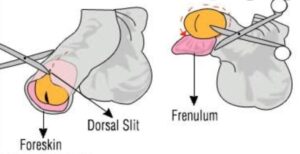What are the problems with Phimosis?
- Hygiene issues: Because the foreskin cannot be retracted, it is difficult to clean the glans (head of the penis). This can lead to infection, pain, or even cancer in the long run!
- Pain: In adults, it can lead to pain while intercourse. In children, it can lead to infection and pain.
- Paraphimosis: If a tight foreskin is pulled back beyond the head of penis, and is not pulled back to normal position, then it may form a tight band and constrict the head of penis, leading to swelling and pain.
- Cancer of Penis:
Long standing Phimosis is a risk factor for development of penile cancer .
- It may increase the risk of sexually transmitted diseases.
It can lead to difficulty in passing urine .
Why should Phimosis not be ignored in adults?
- It may the first and only manifestation of diabetes.
It may be due to an underlying cancer of penis or foreskin.
- It can interfere with normal sexual activity. Some men may start avoiding sex at all out of fear of pain.
- It can lead to Infection or Cancer in long run .
PHIMOSIS IN CHILDREN:
Phimosis in children up to age of four years is physiological and normal. However it needs treatment if child has:
- Pain while passing urine.
- Ballooning of foreskin.
- Repeated episodes of infection
How is Circumcision Done?
In children or anxious adults, it is performed under general anesthesia.
In co- operative adults, it can be done under local anesthesia.
The local anesthesia is given by an injection, whereby numbing medicine is injected circumferentially around base of penis (ring block) and the site of incision.
The foreskin to be removed is marked with a skin marking pain and the skin incised circumferentially at the base of the head of penis.
Bleeding is controlled by suture or a cautery.
The skin is sutured with stitches which are self dissolvable, and generally fall off by end of the month.
A non Sticking Dressing is applied, to be removed after 24-48hours.
The whole procedure takes 15-30 minutes.
